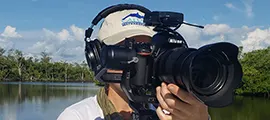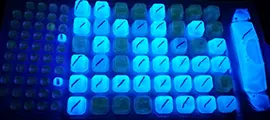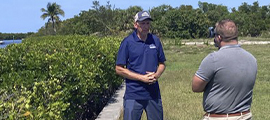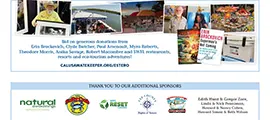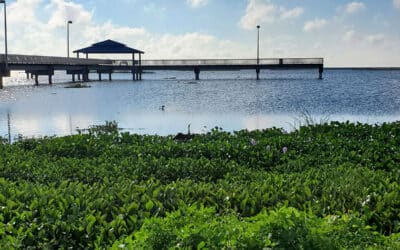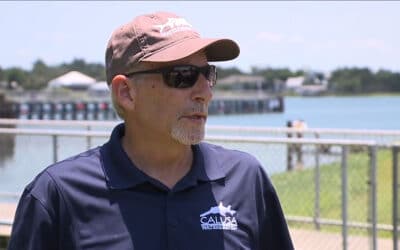Issue:
Lake Okeechobee Discharges

Harmful Discharges
Lake Okeechobee is often referred to as the “liquid heart” of Florida. Unfortunately, over the years, the Lake has become heavily polluted by run-off from agriculture and development in Central & South Florida.
As it was designed in 1947 to avoid flooding south of the lake, the Caloosahatchee and St. Lucie rivers are the two “safety valves” of the system during high water events. Water from Lake Okeechobee is now routinely discharged to these rivers and sent to tide in the Gulf of Mexico and Atlantic Ocean. This practice is also starving Florida Bay of the freshwater it naturally received through the historic Everglades.
In the wet season, massive amounts of nutrient polluted water is now being sent to the Caloosahatchee River. This nutrient rich water is exacerbating harmful algal blooms of increasing scope and frequency.
The federal Army Corps of Engineers is responsible for the Lake’s operation. The Corps’ operational manuals consider public safety and many other objectives set forth by the state’s South Florida Water Management District.
Minimum Flows & Levels
To complicate matters for the Caloosahatchee, our brackish water estuary thrives with a certain amount of freshwater sustaining Vallisneria tape grass near Fort Myers. When dry season rainfall is not enough to suppress salinity levels, tape grass die-offs occur.
As a result of these two seasonal swings, and water mismanagement by government agencies, the Caloosahatchee often suffers from too much freshwater in the wet season, and not enough freshwater in the dry season.

Useful Links
Lake Okeechobee Status

There are a number of tools we use to gather information about the current status of harmful algal blooms on the Lake, as well as the flows being overseen by water managers. Here are a few of the best:
Related News Stories
Lake Okeechobee
Lake Okeechobee leveling off after rains from Hurricane Ian but there’s still a threat
The Lake Okeechobee system is more likely to see a blue-green algal bloom next spring as a result of Hurricane Ian. Lt. Col. Todd Polk with the U.S. Army Corps of Engineers said Ian whipped up waters and stirred nutrients within the system, and that those nutrients could fuel a bloom.
Lake Okeechobee Releases to the Caloosahatchee Begin
The U.S. Army Corps of Engineers said they will begin releasing Lake Okeechobee discharges into the Caloosahatchee River. This raises concerns in Southwest Florida because the area is still trying to dry out after Hurricane Ian.
Lake Okeechobee sees 240 Square Miles of Blue-Green Algae
Lake Okeechobee is seeing about 240 square miles of Blue-Green Algae on the north, west, and south shores. That is about a 30% increase over the last two weeks. The Army Corps of Engineers began to release water from Lake Okeechobee into the Caloosahatchee system.
DeSantis Urged to Veto Lake Okeechobee Water Supply Bill by Four Environmental Nonprofits
Four South Florida environmental nonprofits sent Gov. Ron DeSantis a letter Wednesday urging him to veto a controversial Lake Okeechobee water supply bill. The governor can sign or veto the bill, but if he does nothing, it becomes law on July 1.
Make Your Voice Heard: Oppose SB 2508
Florida Senate bill 2508 surfaced out of nowhere on Friday, February 4th. The bill was fast-tracked skipping the usual committee stops and following another unexpected announcement by the South Florida Water Management District, requesting control of an additional 1.5 feet of Lake Okeechobee above the Water Shortage Band as part of LOSOM.
Stop a Last-Minute Bait and Switch with Lake Okeechobee Management
It has taken us three long years and countless meetings and calls to action to get closer to an attempted balanced approach to managing Lake Okeechobee water levels and discharges, and it is by most accounts, an equitable plan for most interests.
Make a Donation
Get Notified
Priority Issues
Harmful Algal Blooms
Cyanobacteria & Red Tide
Cyanobacteria (blue-green algae) and Karenia brevis (red tide) have been making major impacts on Southwest Florida.
Lake Okeechobee Discharges
Revise System Operating Manual
The Caloosahatchee River often suffers from too much freshwater in the wet season, and not enough freshwater in the dry season.
Cape Coral Spreader Canals
Nutrient & Sediment Loading
The City of Cape Coral is working to remove large storm-water barriers to make recreational boating more convenient.
Bacteria Monitoring
Fecal Indicator Bacteria
Calusa Waterkeeper has been at the forefront of monitoring this Fort Myers tributary for fecal bacteria indicators.







